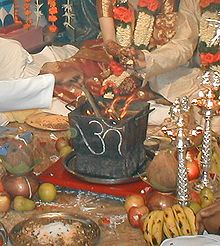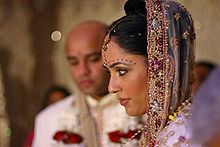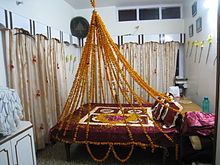- Hindu wedding
-
Practices
Hindu wedding is thought to be the bringing of two people who are said to be compatible. Hindu wedding ceremonies are traditionally conducted at least partially in Sanskrit, the language of most holy Hindu ceremonies. The local language of the people involved is also used since most Hindus do not understand Sanskrit. They have many rituals that have evolved since traditional times and differ in many ways from the modern western wedding ceremony and also among the different regions, families, and castes. The Hindus attach a lot of importance to marriages, and the ceremonies are very colourful and extend for several days.
In India, where most Hindus live, the laws relating to marriage differ by religion. According to 1the Hindu Marriage Act of 1955, passed by the Parliament of India, for all legal purposes, all Hindus of any caste, creed or sect, Sikh, Buddhists and Jains are deemed Hindus and can intermarry. By the Special Marriage Act, 1954, a Hindu can marry a person who is not Hindu, employing any ceremony, provided specified legal conditions are fulfilled.
The pre-wedding ceremonies include engagement (involving vagdana or oral agreement and lagna-patra written declaration), and arrival of the groom's party at the bride's residence, often in the form of a formal procession. The post-wedding ceremonies involve welcoming the bride to her new home.
Despite modern Hinduism being largely based on the puja form of the worship of devas as enshrined in the Puranas, a Hindu wedding ceremony at its core is essentially a Vedic yajna (a fire-sacrifice), in which the Aryan deities are invoked in the Indo-Aryan style. It has a deep origin in the ancient ceremony of cementing the bonds of friendship/alliance (even among people of the same sex or people of different species in mythological contexts), although today, it only survives in the context of weddings. The primary witness of a Hindu marriage is the fire-deity (or the Sacred Fire) Agni, and by law and tradition, no Hindu marriage is deemed complete unless in the presence of the Sacred Fire, seven encirclements have been made around it by the bride and the groom together(In many South Indian Hindu marriages these are not required) .
Contents
The basis for a fulfilling married life
A Vedic sage emphasized that the basis of happy and fulfilling married life is the sense of unity, intimacy and love between husband and wife. Thus, marriage is not for self-indulgence, but rather should be considered a lifelong social and spiritual responsibility. Married life is considered an opportunity for two people to grow from life partners into soul mates.[1][2][3]
Main rituals
Main article: VivahaAll of the rituals vary based on family traditions. Some of the rituals are performed in a slightly different ways in different regions.
During marriage festivities
Saptapadi
The Saptapadi (Sanskrit for seven steps/feet), is perhaps the most important component of Vedic Hindu weddings. The couple conduct seven circuits of the Holy Fire (Agni), which is considered a witness to the vows they make each other.[4] In some regions, sashes worn by the bride and groom are tied together for this ceremony. Elsewhere, the groom holds the bride's right hand in his own right hand.[4] Each circuit of the consecrated fire is led by either the bride or the groom, varying by community and region. Usually, the bride leads the groom in the first circuit. In North India, the first six circuits are led by the bride, and the final one by the groom.[5] In Central India, the bride leads the first three or four circuits.[4] With each circuit, the couple makes a specific vow to establish some aspect of a happy relationship and household for each other.
- the best man will give a speech to the men while his partner gives a speech to the women
- the bridesmaid will carry a young tree that the couple will keep as a sign of a new beginning
- if the bride or groom has children they will not be part of the ceremony as remarriage of children before marriage is frowned on
- the bride will be sprayed with fragrant incense such as rose water by a young girl
In South Indian weddings, after each saying a mantra at each of the seven steps, the couple say these words together:
- "Now let us make a vow together. We shall share love, share the same food, share our strengths, share the same tastes. We shall be of one mind, we shall observe the vows together. I shall be the Samaveda, you the Rigveda, I shall be the Upper World, you the Earth; I shall be the Sukhilam, you the Holder – together we shall live and beget children, and other riches; come thou, O beautiful girl!"[6][7][8][9][10]
In North Indian weddings, the bride and the groom say the following words after completing the seven steps:
- "We have taken the Seven Steps. You have become mine forever. Yes, we have become partners. I have become yours. Hereafter, I cannot live without you. Do not live without me. Let us share the joys. We are word and meaning, united. You are thought and I am sound. May the night be honey-sweet for us. May the morning be honey-sweet for us. May the earth be honey-sweet for us. May the heavens be honey-sweet for us. May the plants be honey-sweet for us. May the sun be all honey for us. May the cows yield us honey-sweet milk. As the heavens are stable, as the earth is stable, as the mountains are stable, as the whole universe is stable, so may our union be permanently settled."[11][12][13][14]
Flower bed ceremony
In the flower bed ceremony the bride wears a lot of floral ornaments and their marriage bed is decorated with flowers by the groom's family. This is the night of consummation. In Hindu marriages, this takes place on the night of the reception.
Further reading
- Michaels, A (2004), Hinduism: Past and Present (5th ed.), Princeton University Press, pp. 111–131, ISBN 0-691-08953-1, http://books.google.com/books?id=PD-flQMc1ocC
References
- ^ Marriage is a Sacred Bond and Pledge http://www.akhandjyoti.org/?Akhand-Jyoti/2003/Mar-Apr/MarriageSacredBond/
- ^ Official Website of All World Gayatri Pariwar http://www.awgp.org/
- ^ Magazine of All World Gayatri Pariwar http://www.akhandjyoti.org/
- ^ a b c Shivendra Kumar Sinha (2008), Basics of Hinduism, Unicorn Books, ISBN 8178061554, http://books.google.com/?id=pSOEETzRVqsC, "The two rake the holy vow in the presence of Agni ... In the first four rounds, the bride leads and the groom follows, and in the final three, the groom leads and the bride follows. While walking around the fire, the bride places her right palm on the groom's right palm and the bride's brother pours some unhusked rice or barley into their hands and they offer it to the fire ..."
- ^ Office of the Registrar General, Government of India (1962), Census of India, 1961, v. 20, pt. 6, no. 2, Manager of Publications, Government of India, http://books.google.com/?id=0sbUAAAAMAAJ, "The bride leads in all the first six pheras but follows the bridegroom on the seventh"
- ^ www.panchangam.com
- ^ South Indian Wedding, SanathanaDharma.com, http://www.sanathanadharma.com/articles/wedding.htm, retrieved 2009-05-21, "... The Ritual of the Hindu Wedding too is each symbolic ..."
- ^ Sapthapathi Manthras – Its meaning, bnaiyer.com, http://www.bnaiyer.com/companion/paths-13.html, retrieved 2009-05-21, "... they both say: "Now let us make a vow together. We shall share the same food, share the strengths ..."
- ^ www.sophieanand.com
- ^ A South Indian Wedding – The Rituals and the Rationale: The Vedic Ceremony of the Tamil Shaivite Brahmin community, SAWNET, http://www.sawnet.org/weddings/tamil_vedic.html, retrieved 2009-05-21, "... The gates of the wedding hall are adorned with full-grown plantain trees, signifying evergreen plenty for endless generations ..."
- ^ Diane Warner (2006), Diane Warner's Complete Book of Wedding Vows: Hundreds of Ways to Say "I Do", Career Press, ISBN 1564148165, http://books.google.com/?id=hdnNZ3U6iG8C, "... We have taken the Seven Steps. You have become mine ..."
- ^ Sitaram Sehgal (1969), Hindu marriage and its immortal traditions, Navyug Publications, http://books.google.com/?id=MwUYAAAAIAAJ, "... May the plants be honey-sweet for us; may the Sun be all honey for us and ..."
- ^ Eleanor C. Munro (1996), Wedding readings: centuries of writing and rituals on love and marriage, Penguin Books, ISBN 0140088792, http://books.google.com/?id=OiALO4j3LpkC, "... May the nights be honey-sweet for us; may the mornings be honey-sweet ..."
- ^ Michael Macfarlane (1999), Wedding Vows: Finding the Perfect Words, Sterling Publishing Company, ISBN 0806906391, http://books.google.com/?id=W987VY-4h3IC, "... we are word and meaning, united ..."
External links
Indian wedding In Hinduism In other religions By region or culture Andhra Pradesh (Telegu) · Arunachal Pradesh (Panchai baja) · Bengal · Bengal (Hindu) · Kerala (Kettu Kalyanam) · Kerala (Mar Thoma) · Orissa · Punjabi · Rajasthan (Rajput) · Sikkim (Limbu) · Tamil (Iyer)Neighbours of India Types Traditions Indian wedding customs · Auspicious wedding date · Baraat · Brahmanippattu · Dowry system · Kanyadan · Mahr · Sarbala · Stealing shoesRituals Balle Mallarada Puje · Gaye holud (Bengali) · Kankana Dharane · Mangal Ashtaka · Pade Puje · Parikrama · Pradakshina · Saptapadi · Satphere · Shakunamanojaya · UpanayanaItems Alta · Bangles · Bhava chakra (birth chart) · Henna · Mangalsutra · Nose ring · Palki · Pheta (turban) · Sehra · Sindoor · Thali necklace · Tiara · Topor (headgear) · Upanayana · Varmala · Wedding mandap · Wedding sariFamily Other Categories:- Weddings by religion
- Marriage in Hinduism
Wikimedia Foundation. 2010.





